Located in the Kotayk Province, roughly 17 miles southeast of the Armenian capital of Yerevan, is the village of Garni. This historical settlement has an ancient history that likely dates back to the construction of its fortress complex in the 3rd century BC. The area itself has been inhabited since the 3rd millennium BC. With a history so long, it should come as no surprise that its historical sites are some of the top things to do in Garni and Geghard, Armenia.

Garni and its surrounding area are chock-full of fascinating historical sites sure to thrill any history buff. Garni’s ancient fortress complex, its churches and shrines, the world-famous Temple of Garni, and the nearby Geghard Monastery can all be easily visited within the same day. Nature-lovers will likely appreciate the beauty of the columnar basalt along the sides of the Garni Gorge. Foodies aren’t left out here, as there are ample opportunities to try traditional Armenian cuisine here as well. These are the top things to do in Garni and Geghard, Armenia.
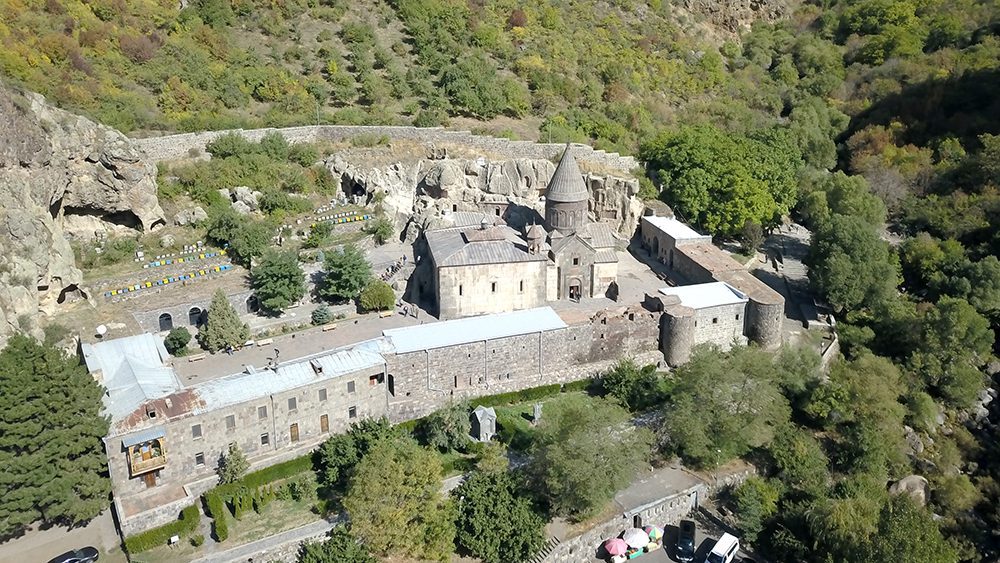
Surrounded by the beautiful and imposing cliffs of the Azrat River Gorge less than five miles northeast of Garni is Geghard Monastery, also known as Geghardavank. While this UNESCO World Heritage Site is technically located in its namesake town, Geghard, it’s close enough to Garni to make it an easy addition to any Garni day trip itinerary.
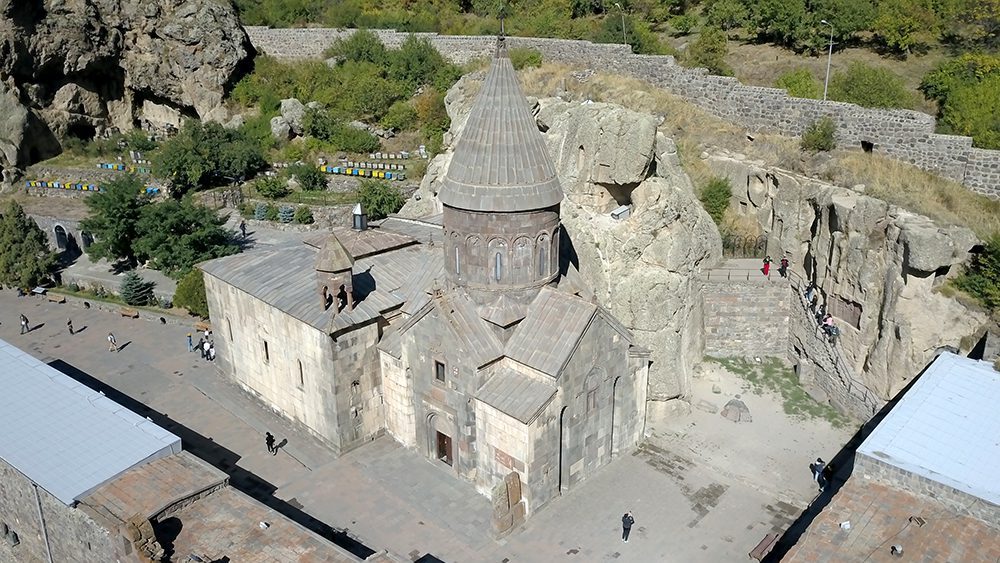
Geghard Monastery is made up of several structures, including caves, jhamatuns (lobby-like entrance areas contiguous to the west of medieval Armenian monasteries), constructed buildings, and more, which are arranged in and adjacent to the Azrat River Gorge cliffside.
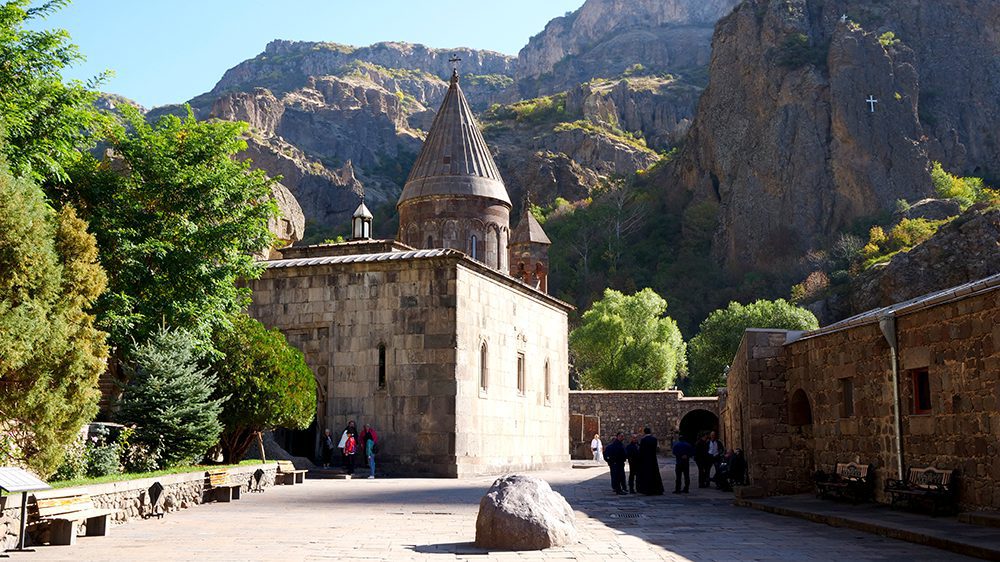
Though the main chapel at Geghard Monastery was built in 1215, the monastery itself dates back much further to the 4th century. It was founded by Gregory the Illuminator, the religious leader who converted Armenia from paganism to Christianity. He founded the monastery on top of a holy spring that was considered sacred even in pre-Christian times.
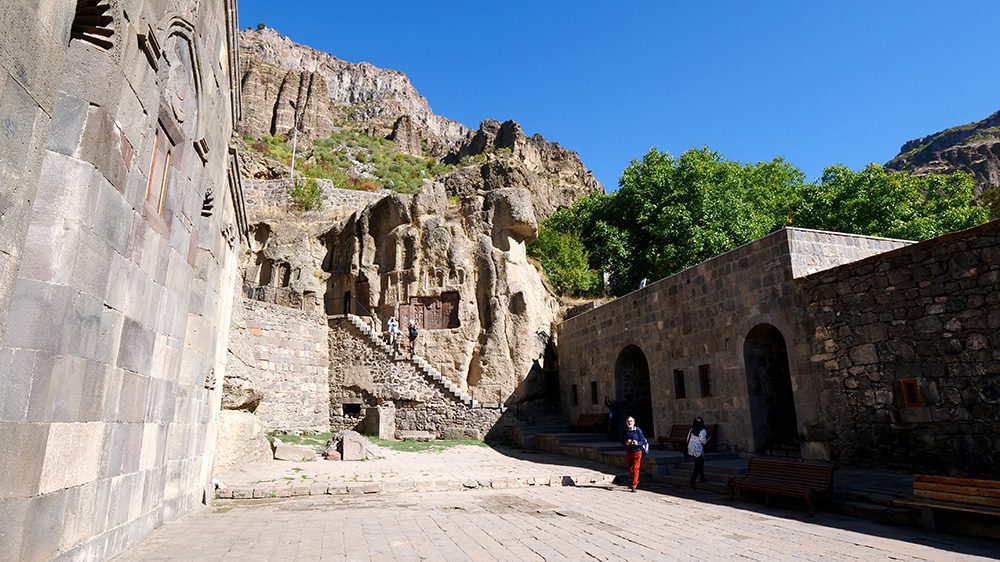
The word “Geghardavank” translates to “Monastery of the Spear,” which is a direct reference to the Spear of Destiny, the artifact that pierced the side of Jesus Christ during the Crucifixion. That spear is thought to have been brought to Geghard Monastery by the Apostle Jude, along with other relics. The spear remained in the monastery from the 13th to 18th centuries but has since been moved to the Etchmiadzin Treasury. The monastery’s significance makes it one of the top things to do in Garni and Geghard.
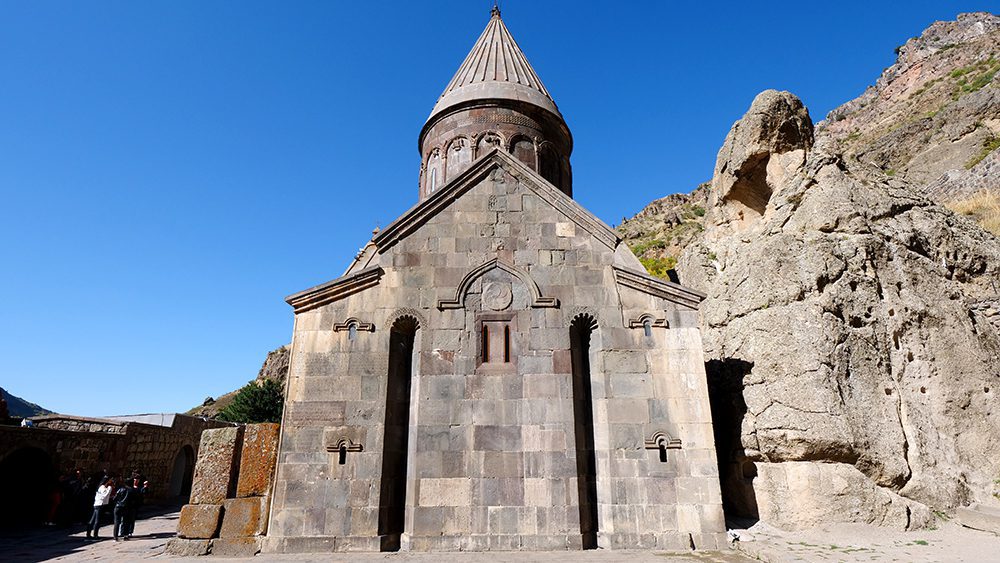
When you first arrive at Geghard Monastery, you’ll find street vendors selling rosaries and other religious items. There are also food vendors selling sweets and dried fruits. My favorite was the gata, a fluffy, Armenian sweet bread made with flour, honey, and sugar. It makes for a sweet and tasty snack before you explore the monastery.
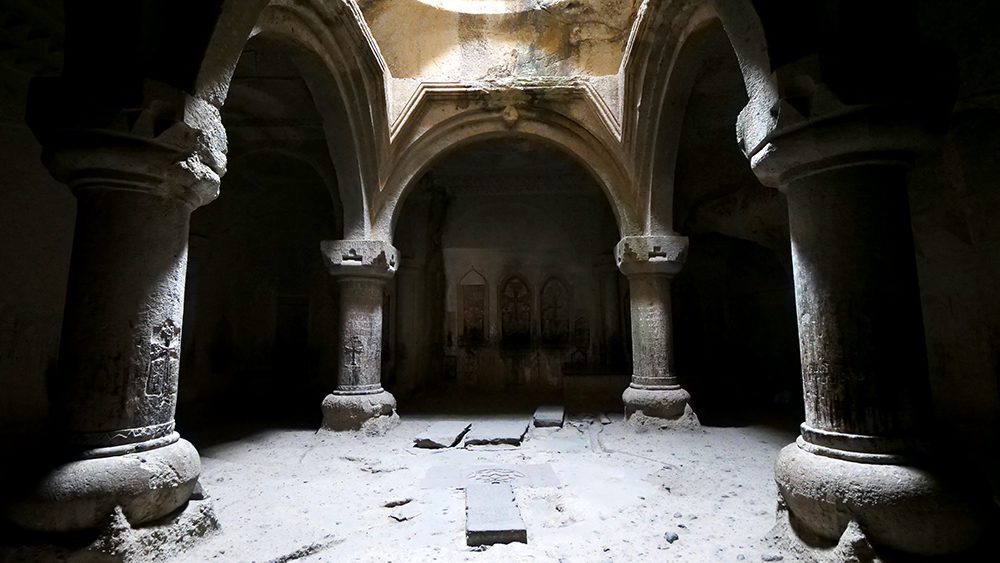
There are lots of different structures that make up the monastery. One of the most fascinating is a 13th century noble family tomb located inside the mountain. This beautiful mausoleum, called the Upper Jhamatun, can be reached by following a cave on the monastery’s second level whose walls are etched with carvings.

The tomb was carved from the top down, so everything inside, including its stunning pillars, walls, and floor, were all hewn from one massive piece of rock. On its walls are Armenian historical records that were documented during the 13th century so they wouldn’t be lost during the frequent Mongol attacks of the time period. Records show that the tomb was completed in the year 1288.

Interred in the tomb are the Armenian princes Merik and Grigor, though others were also buried there once. In addition to the tomb serving as their final resting place, it is also used as a music school. I could see why after witnessing a beautiful song performed by a group of singers there. The acoustics in the tomb are extraordinary and their performance gave me chills! Watching them sing was a privilege and one of my favorite things to do in Garni and Geghard.
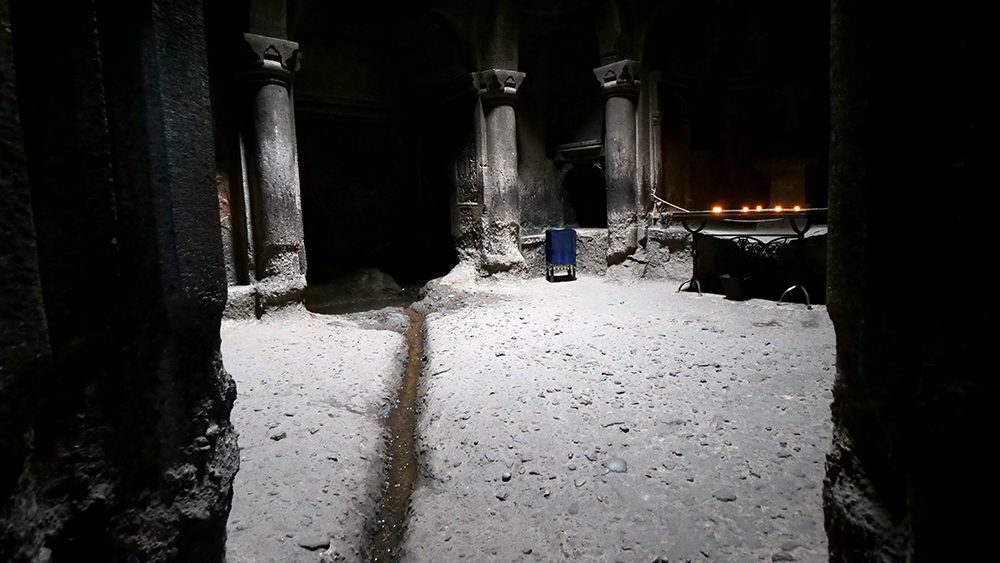
One of the monastery’s more well-known locations is Avazan Church, which was hewn from an ancient cave in the 13th century. The cave in which this rock-cut church was carved is home to a spring that has been a place of worship since Armenia’s pagan days.

The church is cruciform, or cross-shaped, and was carved by the architect Galdzak, who also carved the other jhamatuns and rock-cut churches over the course of 40 years. It’s a little dark inside with light streaming down from a hole above. But after your eyes adjust, you can see the detailing in the wall carvings and columns. It was unlike anything I had ever seen. The design was breathtaking.
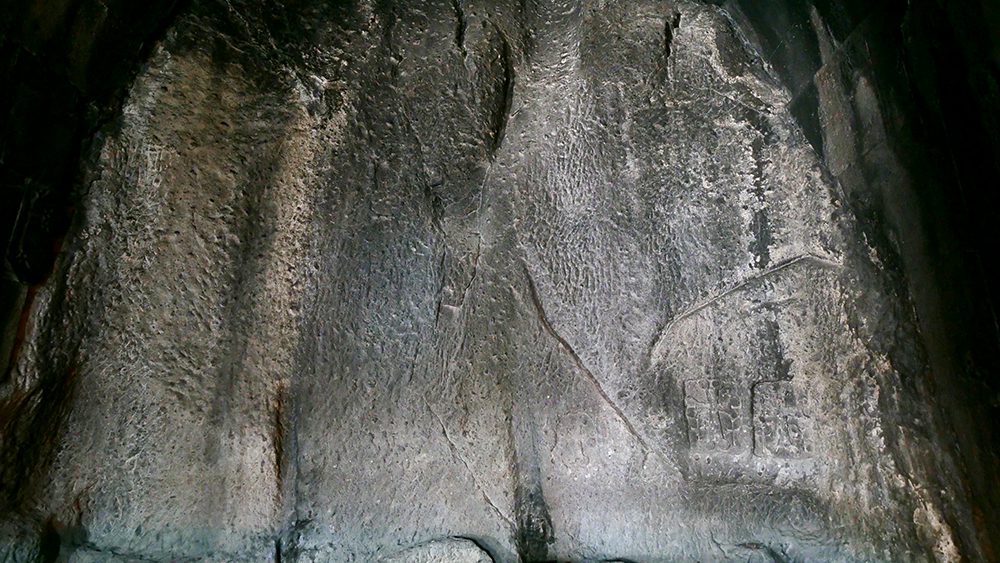
In the back of the Avazan Church is the famous holy spring. It comes straight out of one of the rock walls and trickles down a groove that leads elsewhere. Dip your hands in near the source and take a sip. The water is cold and refreshing! Drinking the water from the holy spring should be high on the list of things to do in Garni and Geghard, Armenia!
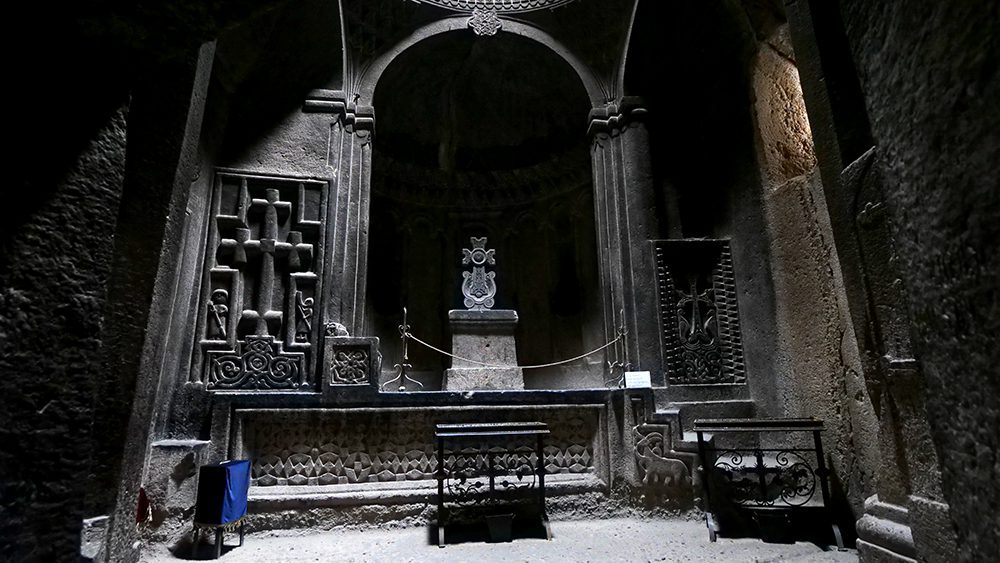
To the left of the chamber with the holy water stream is another rock-carved church. This church was carved from a single piece of rock and features a cupola, as well as more intricate carvings on its walls. I could make out crosses, trees of life, and pomegranates, which I learned are a sign of fertility.
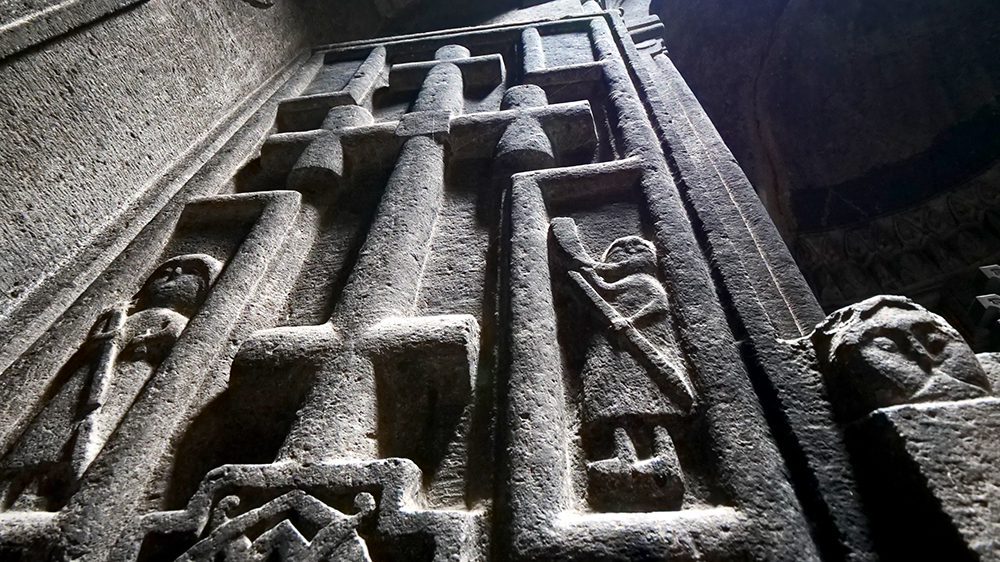
Just outside the rock-cut church is Geghard Monastery’s main church, the Katoghike Chapel. Built in 1215 right against the mountainside, this beautiful church was constructed with specially-made corners to protect the building from seismic activity. Inside, you’ll find vibrant paintings of angels and Jesus Christ on the walls. Outside, on the southern side of the chapel, are more intricate carvings of pomegranate trees, their leaves intertwining with grapes. Seeing it is one of the most beautiful things to do in Garni and Geghard, Armenia!
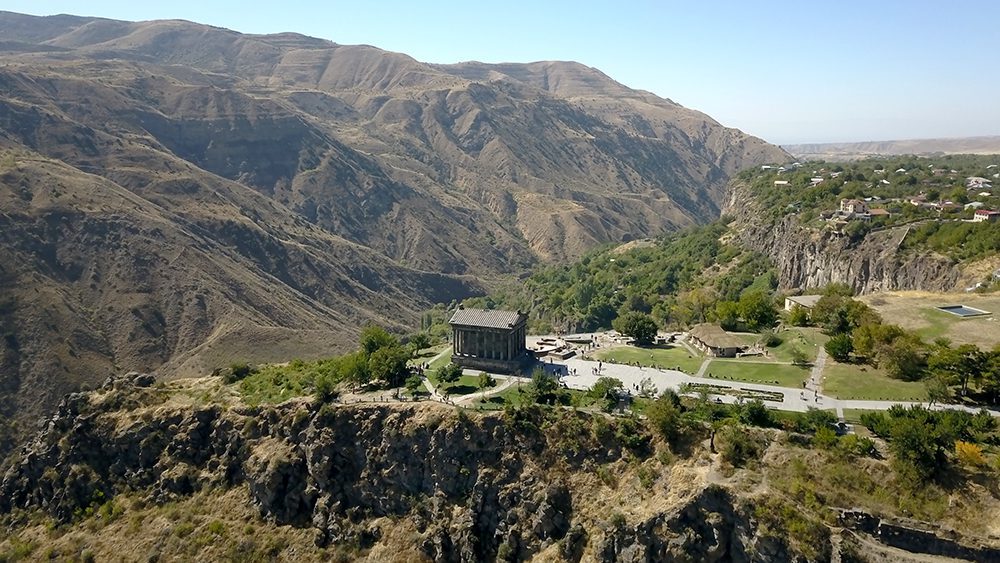
Once you’ve finished up at the gorgeous Geghard Monastery, head on down to the village of Garni. There, you’ll find the magnificent Temple of Garni, a pre-Christian and pre-Hellenistic pagan temple dedicated to the Armenian sun god, Mihr. It’s the only free-standing colonnaded Greco-Roman structure in all of the former Soviet Union. The Temple of Garni is also considered a symbol of Armenia’s classical past.
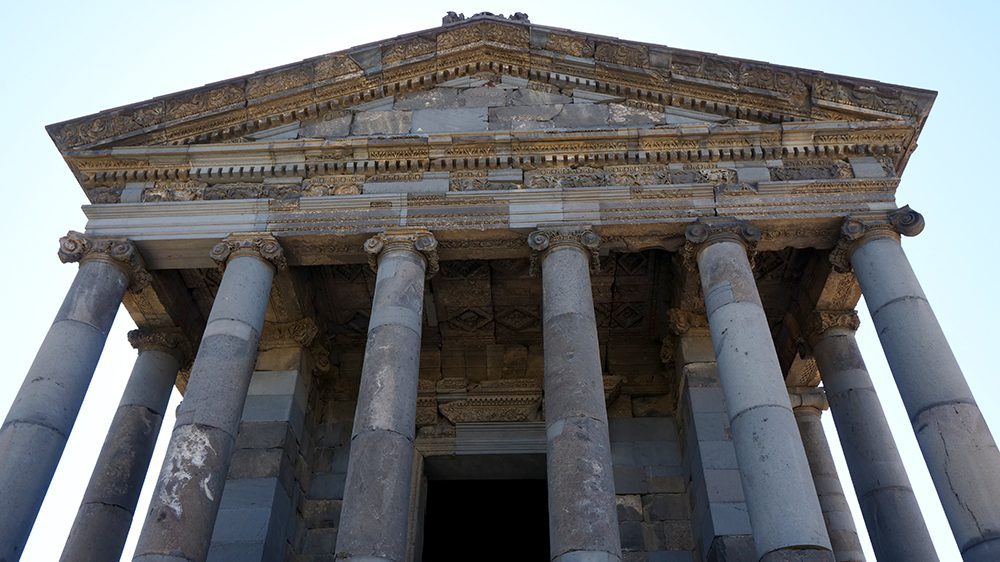
Though the Temple of Garni is a UNESCO World Heritage Site, the structure that stands on the site is not the original temple. The original was likely built by King Tiridates I in the 1st century AD. It was built without the use of cement. Instead, iron was used to unite the stones of the foundation. The temple survived the purge to get rid of pagan temples after Armenia made the shift from polytheism to Christianity, but collapsed during an earthquake in 1679. It was rebuilt from 1969 to 1975.
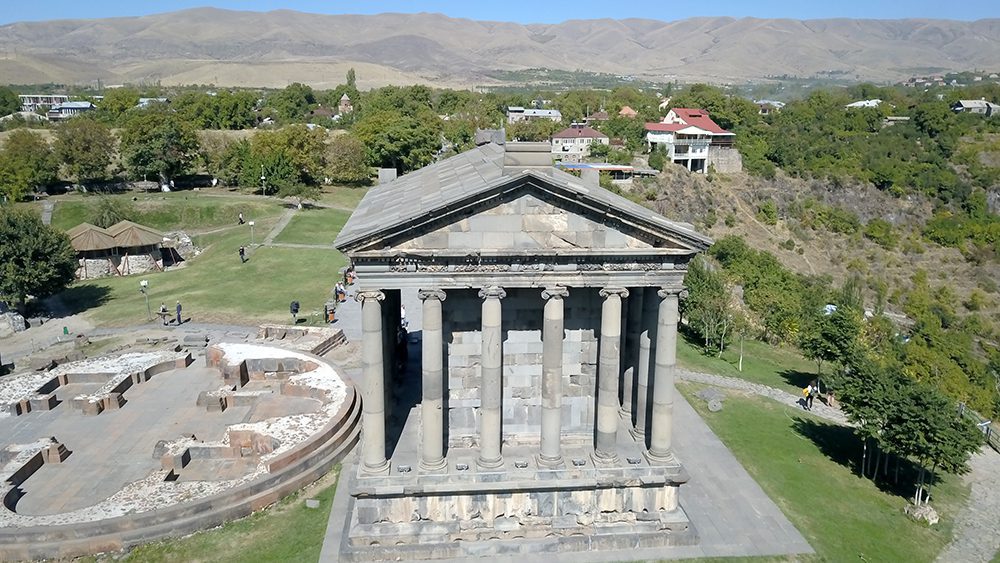
The temple reminded me of ones I had seen during my many trips to Italy. It has 24 columns and steep steps leading up to a main hall and an altar. At the backside of the temple, you can bask in stunning views of the surrounding mountains and valleys. While you’re there, you may even get to listen to a musician play a pipe made from apricot trees called the duduk.

Even rebuilt, the ancient history of the temple and surrounding area is apparent. Excavations have shown that the area has been inhabited since the 4th millennia BC. On the site, you’ll find an 8th-century stone inscribed in Aramaic by King Ardashir I, who wrote of uniting Garniani land with Ararat. Also nearby is the summer residence. Inside is a gorgeous mosaic from the 3rd century, which was made from 14 types of natural stones. It’s very colorful!
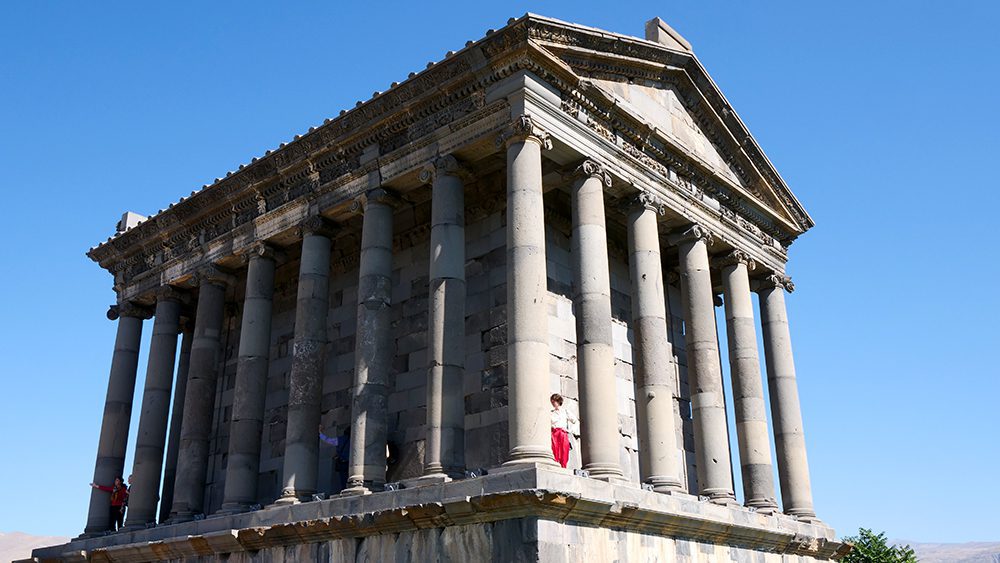
After my visit, I understood why the Temple of Garni is considered a highlight of any trip to Armenia. It was my favorite site I’d visited in the country so far. It should be the cornerstone of things to do in Garni and Geghard, Armenia!
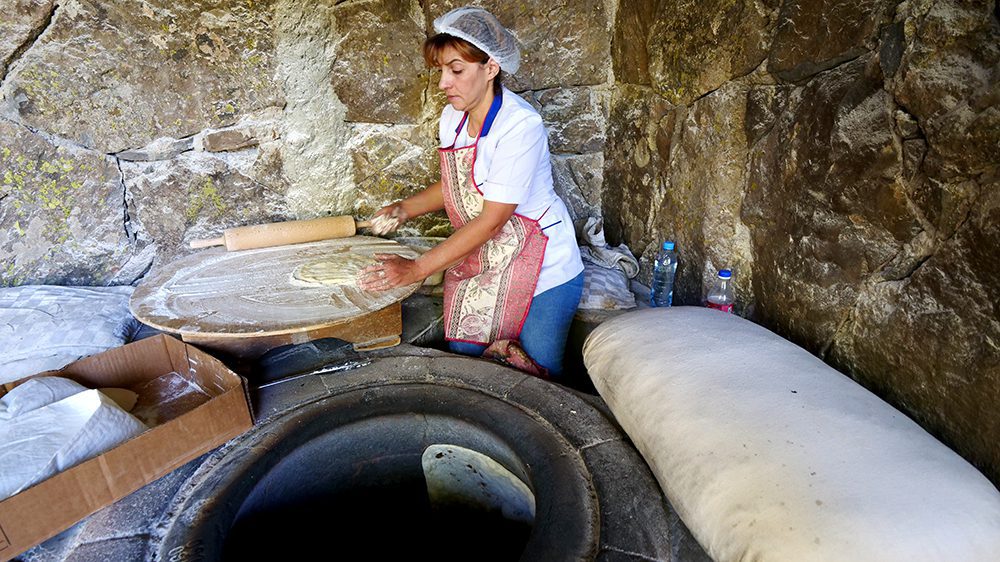
With just a few days in Armenia under my belt by the time I visited Garni, I had already fallen in love with the cuisine. One of my favorite elements of Armenian cuisine is its bread, specifically the lavash. Lavash is a long, thin Armenian flatbread that is often eaten with various cheeses and herbs wrapped inside it. After trying it so many times, I got the chance to learn how to make it at Garnitoun Restaurant in Garni!

First, I watched the baker at the restaurant make her lavash. She quickly rolled out the floured dough, spread it on a pillow, and sprayed it with water. Then, she slaps the dough to the inside wall of an oven called a tonir and lets it cook for a few minutes. She was a lavash-making machine!

Then, it was my turn. I love food, but I admit, I’m not a cook. I didn’t quite get my lavash entirely inside the oven, but it still managed to cook. Unfortunately, I had some trouble pulling it out of the oven once it was ready, though. All in all, let’s just say I won’t be a professional lavash maker anytime soon. But that’s all right, because I prefer eating it to baking it anyway!

Even if you’re not a cook, take some time to learn to make lavash when you visit Garnitoun Restaurant. It’s actually a lot of fun and a great way to learn more about Armenian culture and cuisine. It’s definitely one of the best things to do in Garni and Geghard, Armenia!

After you make your lavash (or in my case, attempt to make lavash), head inside to the restaurant. It features an incredible dining hall with large windows that offer gorgeous views of the surrounding mountains and valleys. You also get an incredible look at the Temple of Garni. If you’re brave enough, step onto the glass floor near the edge of the terrace and get a good look at the valley floor far below!
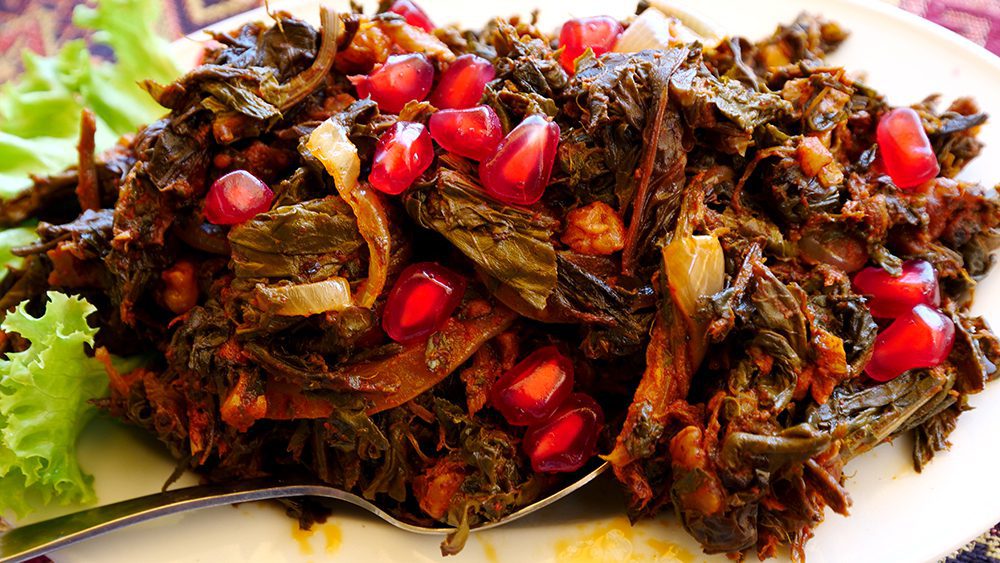
While you enjoy the views, be sure to indulge in some stunning, traditional Armenian food. Of course, I recommend starting with the lavash, which you can stuff with herbs, three different types of cheeses, cream, and even the cucumber and tomatoes from the Greek-style salad. Just trying the lavash is among the best things to do in Garni and Geghard, Armenia!
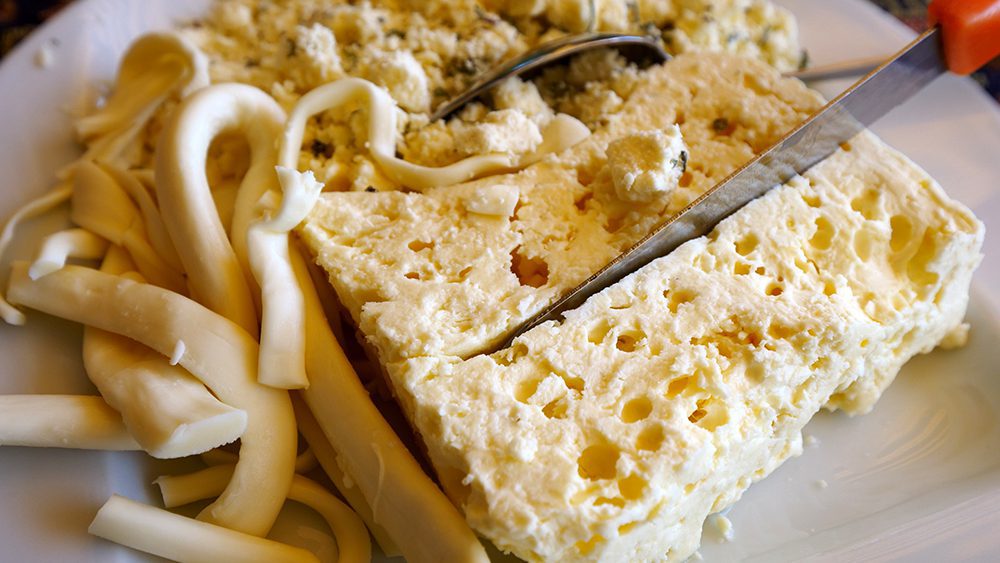
The cheeses here are all so tasty and different from one another. Among them are a string cheese as well as one with herbs in it. The cheeses ferment in clay jars, which are placed underground. They range from mild to tangy and pungent. Combined with the fresh herbs in the lavash, they’re incredibly refreshing!
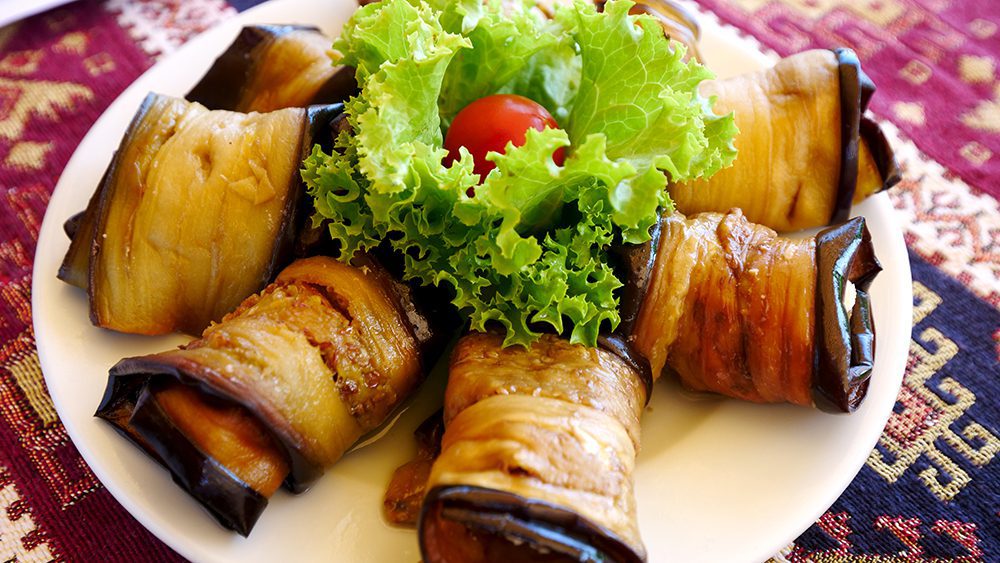
As an eggplant fanatic, I can’t recommend the eggplant stuffed with cheese enough. It comes with a honey-like glaze on top and is unbelievable. I also suggest trying the greens with pomegranate seeds, which add a fruity pop to the earthy greens. You also must try the green bean omelet, which was perfect because the egg was still slightly runny while the beans were undeniably fresh. Don’t miss the dried fruit salad, either. The plums, apple, pomegranate, and apricots are amazing together!
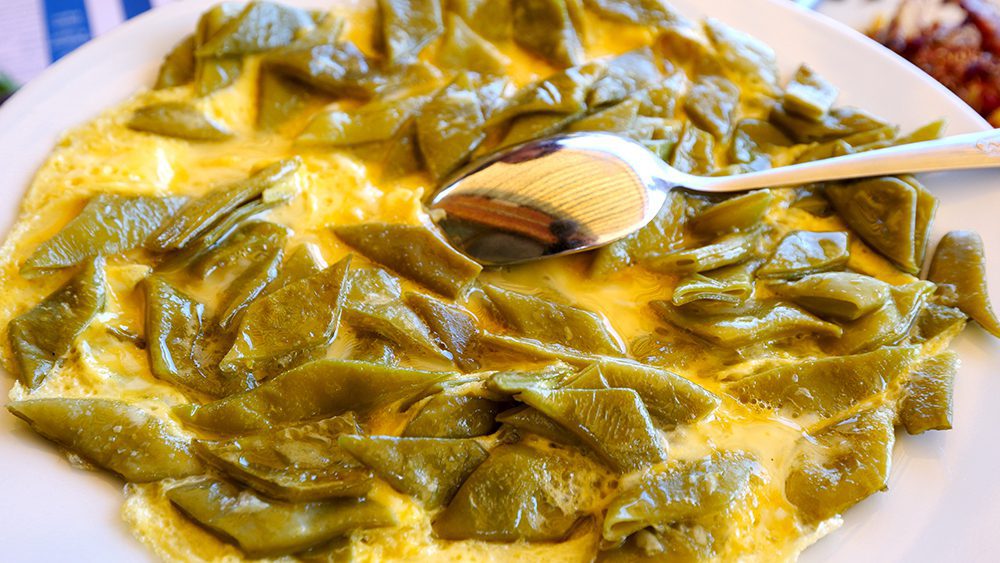
For your main course, my suggestion is to go with the barbecued trout. It’s so tender, it falls apart the moment you spear it on your fork. The meat is buttery and flaky, while everything from the flesh to the crispy skin is full of smoky, mouthwatering flavor. Just be careful, as it contains lots of small bones!

Enjoy your meal with a 2018 VanArdi dry white wine. If you’ve ever had Spanish or Portuguese Albariño wine, the taste is very similar. It pairs so well with the foods and was the perfect cap to a delicious meal with my new friends from Armenia Travel! Having amazing food with amazing people is for sure, one of the best things to do in Garni and Geghard, Armenia.
That concludes my list of the top things to do on a day trip to Garni and Geghard, Armenia! This beautiful village and its surrounding area boasts some of the most remarkable historical sites I visited in Armenia. Spending a day there is something you must do when you visit this Western Asian country. Between the history and the incredible food, I was one happy traveler, and I think you will be, too. Book a trip to Yerevan, Armenia today to experience everything Garni has to offer!
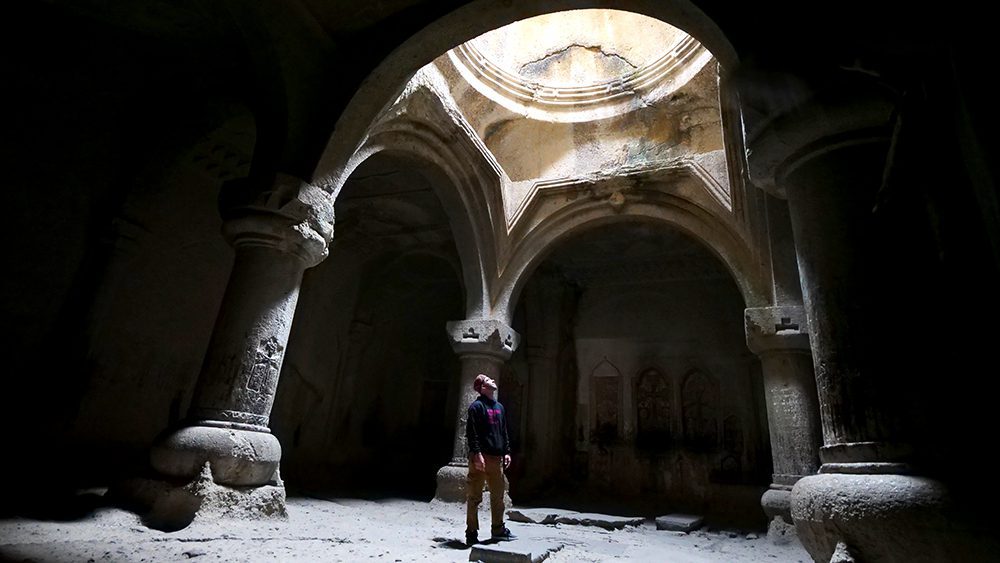
Special thanks to my friends at Armenia Travel for their kindness, hospitality, and for arranging my trip. I couldn’t have done it without them!
Also, if you would like to visit Garni, please contact Lusine.
NOTE: If you need to check the visa requirements of a particular country, click here. To apply for a visa, find up-to-date visa information for different countries, and calculate the cost of a particular visa, click here!
Counter
101 Countries • 1432 Cities